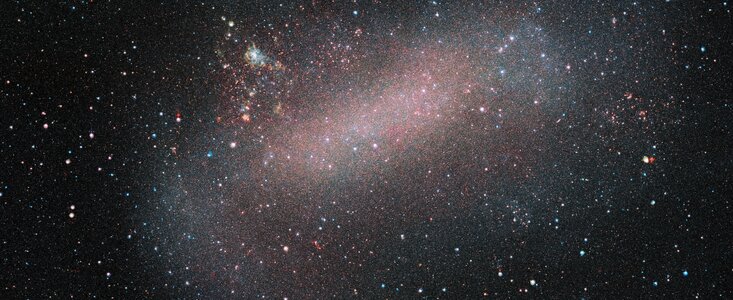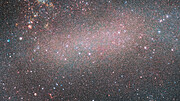Tisková zpráva
Nový snímek Velkého Magellanova oblaku z dalekohledu VISTA
13. září 2019
Přehlídkový dalekohled ESO/VISTA pořídil pozoruhodný nový snímek velkého Magellanova oblaku, jednoho z našich nejbližších galaktických sousedů. VISTA provádí přehlídková pozorování Velkého i Malého Magellanova oblaku a jejich nejbližšího okolí s velmi vysokým rozlišením. Program astronomům umožňuje sledovat velké množství hvězd a otevírá novou cestu ke studiu proměnných hvězd, hvězdného vývoje a dynamiky galaxií.
Velký Magellanův oblak (Large Magellanic Cloud, LMC) je jednou z nejbližších sousedních galaxií, nachází se jen asi 163 tisíc světelných od nás. Spolu se svým společníkem Malým Magellanovým oblakem (Small Magellanic Cloud) patří k nejbližším satelitním galaxiím naší Galaxie (Mléčné dráhy). Velký Magellanův oblak je domovem řady seskupení hvězd a představuje ideální astronomickou laboratoř umožňující studium fyzikálních procesů formujících galaxie.
Dalekohled VISTA se pozorováním této dvojice galaxií zabýval po celé uplynulé desetiletí. Uvedený snímek je výsledkem jednoho z řady přehlídkových programů, které astronomové pomocí tohoto teleskopu provádějí. Hlavním cílem přehlídky VMC (VISTA Magellanic Clouds) je mapování historie hvězdotvorby ve Velkém i Malém Magellanově oblaku a výzkum jejich trojrozměrné struktury.
Pro získání tohoto záběru byly vlastnosti dalekohledu VISTA klíčové. Tento teleskop pozoruje oblohu v oboru blízkého infračerveného záření. To mu umožňuje částečně prohlédnout skrz oblaky prachu, které některé části Velkého Magellanova oblaku zahalují. Oblaky prachu odstiňují většinu viditelného světla, ale pro delší vlny infračerveného záření, k jejichž sledování byl dalekohled VISTA sestrojen, jsou téměř průhledné. Díky tomu mohou astronomové bez problémů pozorovat mnohem větší počet hvězd obývajících centrální části této galaxie. Na záběrech Velkého Magellanova oblaku vědci identifikovali asi deset milionů jednotlivých stálic a pomocí nejnovějších modelů vývoje hvězd [1] určili jejich stáří. Zjistili, že mladší hvězdy vytvářejí v galaxii několik spirálních ramen.
Objekt dnes známý jako Velký Magellanův oblak fascinoval obyvatele jižní polokoule po tisíciletí, Evropanům však byl zcela neznámý až do období zámořských objevů. Jméno, které dnes používáme, objekt získal na počest objevitele Ferdinanda Magellana, který před 500 lety zahájil svou plavbu kolem světa. Záznamy, které z expedice přivezl zpět do Evropy, poprvé představily Evropanům řadu míst i nebeských objektů. Objevitelský duch v tomto smyslu dodnes přežívá v práci astronomů z celého světa, včetně týmu přehlídky VMC, jehož úsilí se vtělilo do tohoto působivého záběru Velkého Magellanova oblaku.
Poznámky
[1] Modely hvězdného vývoje astronomům umožňují předpovědět průběh života stálic a poskytují tak informace o jejich vlastnostech – stáří, hmotnosti nebo teplotě.
Další informace
Výzkum hvězd sledovaných v rámci této přehlídky byl publikován v článku “The VMC Survey - XXXIV. Morphology of Stellar Populations in the Magellanic Clouds”, který byl zveřejněn ve vědeckém časopise Monthly Notices of the Royal Astronomical Society.
ESO je nejvýznamnější mezivládní astronomická organizace v Evropě, která v současnosti provozuje nejproduktivnější pozemní astronomické observatoře světa. ESO má 16 členských států: Belgie, Česko, Dánsko, Finsko, Francie, Irsko, Itálie, Německo, Nizozemsko, Portugalsko, Rakousko, Španělsko, Švédsko, Švýcarsko, Velká Británie a dvojici strategických partnerů – Chile, která hostí všechny observatoře ESO, a Austrálii. ESO uskutečňuje ambiciózní program zaměřený na návrh, konstrukci a provoz výkonných pozemních pozorovacích komplexů umožňujících astronomům dosáhnout významných vědeckých objevů. ESO také hraje vedoucí úlohu při podpoře a organizaci celosvětové spolupráce v astronomickém výzkumu. ESO provozuje tři unikátní pozorovací střediska světového významu nacházející se v Chile: La Silla, Paranal a Chajnantor. Na Observatoři Paranal, nejvyspělejší astronomické observatoři světa pro viditelnou oblast, pracuje VLT (Velmi velký dalekohled) a dva přehlídkové teleskopy – VISTA a VST. Dalekohled VISTA pozoruje v infračervené části spektra a je největším přehlídkovým teleskopem světa, dalekohled VST je největším teleskopem navrženým k prohlídce oblohy ve viditelné oblasti spektra. ESO je významným partnerem zařízení APEX a revolučního astronomického teleskopu ALMA, největšího astronomického projektu současnosti. Nedaleko Observatoře Paranal, na hoře Cerro Armazones, staví ESO nový dalekohled ELT (Extrémně velký dalekohled) s primárním zrcadlem o průměru 39 m, který se stane „největším okem lidstva hledícím do vesmíru“.
Odkazy
Kontakty
Maria-Rosa Cioni
Leibniz-Institut für Astrophysik Potsdam (AIP)
Potsdam, Germany
Tel.: +49 331 7499 651
Email: mcioni@aip.de
Mariya Lyubenova
ESO Head of Media Relations
Garching bei München, Germany
Tel.: +49 89 3200 6188
Email: pio@eso.org
Anežka Srbljanović (press contact Česko)
ESO Science Outreach Network
a Astronomical Institute of Czech Academy of Sciences
Tel.: +420 323 620 116
Email: eson-czech@eso.org
O zprávě
| Tiskové zpráva č.: | eso1914cs |
| Jméno: | Large Magellanic Cloud |
| Typ: | Local Universe : Galaxy : Type : Irregular |
| Facility: | Visible and Infrared Survey Telescope for Astronomy |
| Instruments: | VIRCAM |
| Science data: | 2019MNRAS.490.1076E |
Our use of Cookies
We use cookies that are essential for accessing our websites and using our services. We also use cookies to analyse, measure and improve our websites’ performance, to enable content sharing via social media and to display media content hosted on third-party platforms.
ESO Cookies Policy
The European Organisation for Astronomical Research in the Southern Hemisphere (ESO) is the pre-eminent intergovernmental science and technology organisation in astronomy. It carries out an ambitious programme focused on the design, construction and operation of powerful ground-based observing facilities for astronomy.
This Cookies Policy is intended to provide clarity by outlining the cookies used on the ESO public websites, their functions, the options you have for controlling them, and the ways you can contact us for additional details.
What are cookies?
Cookies are small pieces of data stored on your device by websites you visit. They serve various purposes, such as remembering login credentials and preferences and enhance your browsing experience.
Categories of cookies we use
Essential cookies (always active): These cookies are strictly necessary for the proper functioning of our website. Without these cookies, the website cannot operate correctly, and certain services, such as logging in or accessing secure areas, may not be available; because they are essential for the website’s operation, they cannot be disabled.
Functional Cookies: These cookies enhance your browsing experience by enabling additional features and personalization, such as remembering your preferences and settings. While not strictly necessary for the website to function, they improve usability and convenience; these cookies are only placed if you provide your consent.
Analytics cookies: These cookies collect information about how visitors interact with our website, such as which pages are visited most often and how users navigate the site. This data helps us improve website performance, optimize content, and enhance the user experience; these cookies are only placed if you provide your consent. We use the following analytics cookies.
Matomo Cookies:
This website uses Matomo (formerly Piwik), an open source software which enables the statistical analysis of website visits. Matomo uses cookies (text files) which are saved on your computer and which allow us to analyze how you use our website. The website user information generated by the cookies will only be saved on the servers of our IT Department. We use this information to analyze www.eso.org visits and to prepare reports on website activities. These data will not be disclosed to third parties.
On behalf of ESO, Matomo will use this information for the purpose of evaluating your use of the website, compiling reports on website activity and providing other services relating to website activity and internet usage.
Matomo cookies settings:
Additional Third-party cookies on ESO websites: some of our pages display content from external providers, e.g. YouTube.
Such third-party services are outside of ESO control and may, at any time, change their terms of service, use of cookies, etc.
YouTube: Some videos on the ESO website are embedded from ESO’s official YouTube channel. We have enabled YouTube’s privacy-enhanced mode, meaning that no cookies are set unless the user actively clicks on the video to play it. Additionally, in this mode, YouTube does not store any personally identifiable cookie data for embedded video playbacks. For more details, please refer to YouTube’s embedding videos information page.
Cookies can also be classified based on the following elements.
Regarding the domain, there are:
- First-party cookies, set by the website you are currently visiting. They are stored by the same domain that you are browsing and are used to enhance your experience on that site;
- Third-party cookies, set by a domain other than the one you are currently visiting.
As for their duration, cookies can be:
- Browser-session cookies, which are deleted when the user closes the browser;
- Stored cookies, which stay on the user's device for a predetermined period of time.
How to manage cookies
Cookie settings: You can modify your cookie choices for the ESO webpages at any time by clicking on the link Cookie settings at the bottom of any page.
In your browser: If you wish to delete cookies or instruct your browser to delete or block cookies by default, please visit the help pages of your browser:
Please be aware that if you delete or decline cookies, certain functionalities of our website may be not be available and your browsing experience may be affected.
You can set most browsers to prevent any cookies being placed on your device, but you may then have to manually adjust some preferences every time you visit a site/page. And some services and functionalities may not work properly at all (e.g. profile logging-in, shop check out).
Updates to the ESO Cookies Policy
The ESO Cookies Policy may be subject to future updates, which will be made available on this page.
Additional information
For any queries related to cookies, please contact: pdprATesoDOTorg.
As ESO public webpages are managed by our Department of Communication, your questions will be dealt with the support of the said Department.








